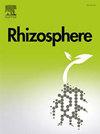Deep tillage improves the rhizosphere environment in rainfed coffee cultivation on dense Cambisols through plant-soil interaction
IF 3.4
3区 生物学
Q1 PLANT SCIENCES
引用次数: 0
Abstract
Deep tillage alleviates drought stress in dense soils through soil-root interactions, serving as a key adaptation to climate change. Enhancing soil structure for root growth and water retention, supported by geostatistical techniques, is crucial for informed decision-making in sustainable agriculture. This study evaluated the effects of deep tillage methods and chemical amendments on soil properties and coffee plant performance in Nazareno, Minas Gerais, Brazil, on a clay-loam Cambisol. A randomized complete block design with split-plot arrangement was used, including three blocks, six depths (0–0.05, 0.15–0.20, 0.35–0.40, 0.55–0.60, 0.60–0.70, and 0.75–0.80 m), and five treatments: SP40 (furrower at 0.40 m), SP60 (Big Mix at 0.60 m, with liming as SP60AL), and SP80 (soil homogenizer at 0.60 m, subsoiler at 0.80 m, with liming as SP80AL). After five years, undisturbed soil samples were collected at different depths in the experimental area and an adjacent site under native Cerrado vegetation. In trenches, soil penetration resistance (PR), root growth, and chemical element contents were analyzed. Soil moisture was assessed using a probe from October 2019 to March 2021. ANOVA, Scott-Knott, and Dunnett tests (p < 0.05) were used for data analysis. Geostatistical kriging mapped PR, root variables, element contents, and soil moisture. SP60 improved soil structure, root growth, and water uptake, enhancing antioxidant activity under drought. SP80AL enhanced water retention and root development up to 0.70 m but had lower drought tolerance. Geostatistical mapping was crucial for understanding deep tillage impacts on rhizosphere management, aiding sustainable coffee cultivation.

深耕通过植物-土壤相互作用改善了雨养咖啡在Cambisols上的根际环境
深耕通过土壤与根系的相互作用缓解了致密土壤的干旱胁迫,是适应气候变化的关键手段。在地质统计技术的支持下,改善土壤结构以促进根系生长和保水,对可持续农业的知情决策至关重要。本研究评估了深耕方法和化学改良剂对巴西米纳斯吉拉斯州纳扎雷诺市Cambisol粘土壤土土壤性质和咖啡树生长性能的影响。采用分块式随机完全区组设计,包括3个区组,6个深度(0-0.05、0.15-0.20、0.35-0.40、0.55-0.60、0.60 - 0.70和0.75-0.80 m), 5个处理:SP40 (0.40 m深度的犁沟机)、SP60 (0.60 m深度的大混合,施石灰为SP60AL)和SP80 (0.60 m深度的土壤均质机、0.80 m深度的深耕机,施石灰为SP80AL)。五年后,在试验区和邻近塞拉多原生植被下的不同深度收集了未受干扰的土壤样本。在沟内分析土壤穿透阻力(PR)、根系生长和化学元素含量。从2019年10月到2021年3月,使用探针评估了土壤湿度。方差分析、Scott-Knott检验和Dunnett检验(p <;0.05)进行数据分析。地质统计克里格绘制了PR、根变量、元素含量和土壤湿度。SP60改善了土壤结构、根系生长和水分吸收,增强了干旱条件下的抗氧化活性。SP80AL提高了0.70 m的保水能力和根系发育,但耐旱性较差。地质统计制图对于了解深耕对根际管理的影响,帮助咖啡可持续种植至关重要。
本文章由计算机程序翻译,如有差异,请以英文原文为准。
求助全文
约1分钟内获得全文
求助全文
来源期刊

Rhizosphere
Agricultural and Biological Sciences-Agronomy and Crop Science
CiteScore
5.70
自引率
8.10%
发文量
155
审稿时长
29 days
期刊介绍:
Rhizosphere aims to advance the frontier of our understanding of plant-soil interactions. Rhizosphere is a multidisciplinary journal that publishes research on the interactions between plant roots, soil organisms, nutrients, and water. Except carbon fixation by photosynthesis, plants obtain all other elements primarily from soil through roots.
We are beginning to understand how communications at the rhizosphere, with soil organisms and other plant species, affect root exudates and nutrient uptake. This rapidly evolving subject utilizes molecular biology and genomic tools, food web or community structure manipulations, high performance liquid chromatography, isotopic analysis, diverse spectroscopic analytics, tomography and other microscopy, complex statistical and modeling tools.
 求助内容:
求助内容: 应助结果提醒方式:
应助结果提醒方式:


